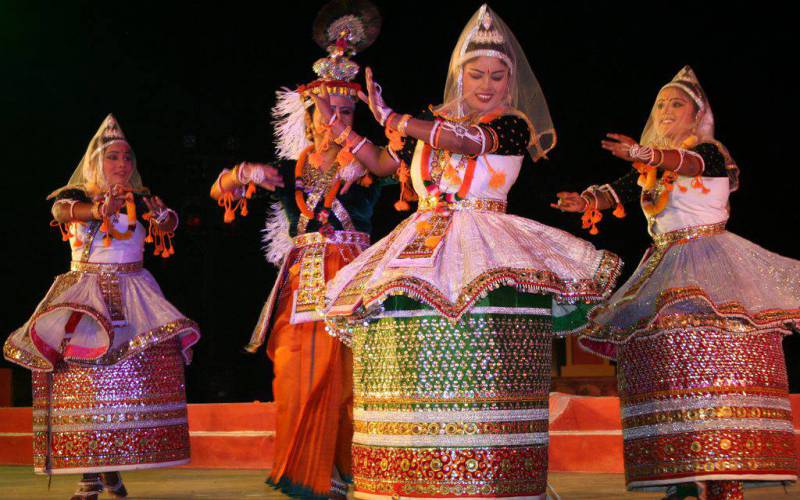Introduction
Manipur is famous for its special fabrics like moiraingphee, leirum, lasingphee and phanek. Tribal textiles are woven on a loin-loom, a type of back-strap loom commonly used by hill people. The warp of manageable length and breadth is prepared and fastened at one end generally to the wall of a house or to two fixed poles while the other is tied to the waist of the weaver with a cotton or leather belt. Sometimes the belt is woven out of cane or bamboo. Weaving is universal and every girl knows how to weave. The loom forms part of her dowry. Weaving is done purely for personal use, by the women, while highly organized commercial weaving is done by men.
There is an aura of religion and romance around cotton-weaving. Each process and design is highlighted by a legend and connected with special functions, dances, and ceremonies. Ningthou phee and akoibi are based on snake motifs and the design is worn by royalty. These designs are mostly found on the phaneks. Tradition has it that when a weaver used to sit down to weave the ningthou phee, the royal design, a gun salute would be fired in honor. A black shawl with thick, bold embroidered animal motifs is called the angami naga (sami lami phee). It was given to brave and distinguished warriors by the royalty, in recognition of their prowess and ability. Phaneks are woman’s lungies and the morang phee is the traditional Manipuri sari with a temple border. Likli or bottle designs resembling a loom-accessory and lasing phee (a quilted design to keep warm in winter as Manipur has no wool) are popular. Shamilami is a combination of weaving and embroidery once considered a status symbol. The maibung is said to be a copy of a natural design, resembling the grains of wood as revealed when it is chopped clean. Hijamayak, which is a boat form, has a restricted use as it is associated with death ceremonies. Horses, swords, and spears for use in rituals form motifs of typical borders in saris. The patterns in use here are typical of the region. Bold colours and geometrical patterns are in evidence in most of their textiles.
The lasingphee (quilted cotton material) is produced in Manipur and used as a covering in winter. Colours are obtained from natural sources and the juice of wild indigo is used as a black or dark blue dye. A bark from the plains is used for a red shade, and green, yellow, and orange are obtained from the barks of jungle trees. A characteristic feature of the moirangphi chaddar is the triangular form along the border. Phi means cloth in Meithei and Moirang is the name of a place in Manipur. Morangfi saris woven in white or soft colours carry the mandir shikhara (temple top) on the border with dotted patterns on the body. There is a belief that this pattern was created by the Goddess Morangfi herself.
Manipur is said to be the original home of the mulberry silk worm, and it is said that it went from there to China. However, most silk-weaving is eri weaving. The use of tassar is also being encouraged.
ART AND CULTURE
Its own art-forms and cultural expressions and ramifications distinctly showcase Manipur to the World. Its famous classical dance remains unique in all Manipuri dance forms whether it’s folk, classical or modern and has a different style and gesture of movement.
Love of art and beauty is inherent in the people and it is difficult to find a Manipuri girl who cannot sing or dance. Manipuris are artistic and creative by nature. This has found expression in their handloom and handicraft products, which are world-famous for their designs, ingenuity, colorfulness and usefulness.
Each ethnic group has its own distinct culture and tradition deeply embedded in its dances, music, customary practices and pastimes.
RAS-LILA
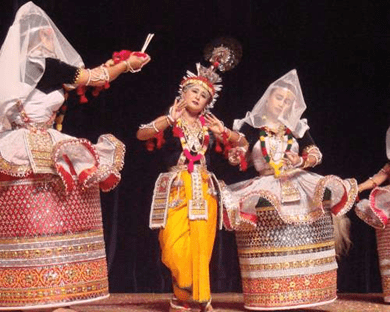
Ras Lila:-The Ras lila, the epitome of Manipuri classical dance is inter-woven through the celestial and eternal love of Radha and Krishna as has been described in the Hindu scriptures and reveals the sublime and transcendental love of Krishna and Radha and the Gopies’ devotion to the Lord. It is generally performed in an enclosure in front of the temple throughout the night and watched with a deep sense of devotion. Ras performances are seasonal and varied and performed at the temple of Shree Shree Govindajee in Imphal on the nights of Basanta Purnima, Sarada Purnima and Kartik Purnima and at local temples later. As to the composition, the performance is a combination of solo, duet and group dances. This highly stylised form of dance has sublimity, subtlety and grace. The richness of the costumes gives lustre to the beauty of the art.
Nupa Pala

Nupa Pala:-Nupa Pala which is otherwise known as Kartal Cholom or Cymbal Dance is a characteristic of the Manipuri style of dance and music. The initial movements of this dance are soft and serene , gradually gathering momentum. It is a group performance of male partners, using cymbals and wearing snow white ball-shaped large turbans, who sing and dance to the accompaniment of Mridanga, an ancient classical drum “Pung” as it is called in Manipuri. The Nupa Pala acts as a prologue to the Ras Lila dances, besides an independent performance too, in connection with religious rites.
Pung Cholom

Pung Cholom:-Pung or Manipuri Mridanga is the soul of Manipuri Sankritana music and Classical Manipuri Dance. It assumes an important ritual character, an indispensable part of all social and devotional ceremonies in Manipur,-the instrument itself becoming an object of veneration. Pung Cholom is performed as an invocatory number preceding the Sankirtana and Ras Lila. It is highly refined classical dance number characterised by the modulation of sound from soft whisper to a thunderous climax.
There is the interplay of intricate rhythms and cross rhythms with varying markings of time from the slow to the quick with graceful and vigorous body movements leading to ecastic heights.
Maibi dance

Maibi Dance:-During the festival of Lai-Haraoba which is an annual ritual festival of the Meiteis, the inhabitants of the valley of Manipur, the Maibis, the priestesses considered to be spritural mediums, trace through their dances the whole concept of cosmogony of the Meitei people and describe their way of life. Beginning with the process of creation, they show the construction of houses and various occupations of the people to sustain themselves. It is a kind of re-living of the way of life of the past.
Khamba Thoibi dance
Khamba Thoibi Dance:-Khamba Thoibi dance is a duet of male and female partners, a dance of dedication to the sylvan deity, Thangjing of Moirang , is the depiction of the dance performed by Khamba and Thoibi, the hero and heroine of the Moirang episode of the hoary past. This, with the “Maibi” dance (Priestess dance) , the “Leima Jagoi” etc. form the “Laiharaoba” dance. The “Laiharaoba” dance , in many ways, is the fountainhead of the modern Manipuri dance form.This dance is a part and parcel of Moirang Lai-Haraoba. It is belived that the legendary hero – Khamba and heroin – Thoibi danced together before the Lord Thangjing, a celebrated deity of Moirang, a village in the South-West of Manipur which is known for its rich cultural traditions, for peace and prosperity of the land.
TRIBES OF MANIPUR
Manipur is a multi-ethnic state located at the easternmost part of India. It has a total population of 28, 55,794 according to 2011 Census of India covering an area of 22,327 square kilometers. Out of this, 58.9% represents the valley population and 41.1% represents the population of the hills.
The hills are inhabited mainly by the tribals with a total population of 11, 67,422. Of which, there are 33 recognised tribes (in Manipur) which either fall under the Nagas or the Kukis, the two different conglomerates of Manipur tribals. The two communities are differentiated mainly from their distinctive dialects, costumes, cultures and traditions. The Nagas have a history of headhunting and a strong warrior tradition whereas the Kukis are a sub-family of the Tibeto-Burman language group which is also related to Mizos of Mizoram and Chins in Myanmar.
The recognized tribes who made their home in Manipur for years now are Aimol, Anal, Chiru, Chothe, Gangte, Inpui, Hmar, Kharam, Khoibu, Koirao, Kom, Lamkang, Liangmai, Mao, Maram, Maring, Mate, Monsang, Moyon, Paite, Poumai, Purum, Ralte, Rongmei (Kabui), Simte, Suhte, Tangkhul, Tarao, Thadou, Thangal, Vaiphei, Zeme and Zou.
All the tribes generally communicate in their own dialects among the same ethnic groups while communication between different groups is carried out in Meitei or Manipuri language, the official language of Manipur. Despite the socio-political and linguistic differences among them, all the ethnic tribes originate from the same Mongoloid group having similarities in cultural and traditional domains. Rice is consumed as the main food by all tribes of Manipur whereas meat, fish and seasonal vegetables are being the favorites.
In this blog, we shall discuss 10 out of the total 33 tribes of Manipur and follow up with a series of two more blogs studying the remaining tribes. The descriptions of the recognised scheduled tribes of Manipur are as below.
Aimol: Aimol is listed under the Kuki tribes found living both in Assam and Manipur. They speak Aimol language, classified under Kuki-Chin-Mizo language. They are based in parts of Chandel district, Senapati district and around Loktak Lake in Bishnupur district. They practice slash and burn agriculture and are primarily Christians.

Anal: The Anal tribe is one of the oldest dwellers in the Southern hills of Tengnoupal district. They were recognized as a tribe in 1951. Earlier they were recognized as one of the oldest Kuki tribes but nowadays they identify themselves as a Naga tribe.

Chiru: Chirus are one of the earliest inhabitants of Manipur and Assam. It was recognized as a Scheduled Tribe in 1956. They are found in four districts of the state, in Tamenglong, Kangpokpi, Churachandpur and Thoubal district. They speak Chiru dialect, one of Kuki-Chin-Naga languages.
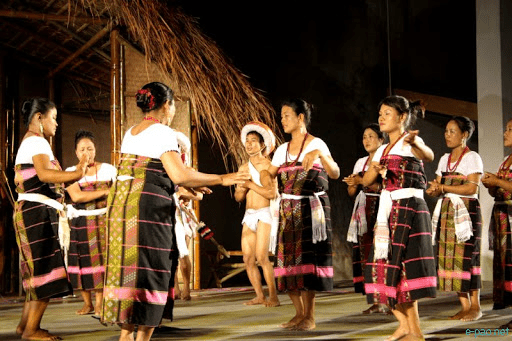
Chothe: They are settled in Chandel and Bishnupur districts and speak a Kuki-Chin dialect. Their main occupations are cultivation, livestock rearing, blacksmith and weaving. They are divided into seven clans.
Hmar: They belong to Kuki-Chin-Mizo group concentrated mainly in Churachandpur district. Agriculture and weaving are their main occupations. They adopted Christianity from 1910. Hmar have their village administration consisting of Lal (Chief), Khawnbawlupa (chief minister), Khonbols (ministers).
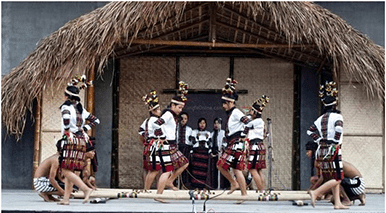
Kharam: They are settled in 7 villages in Senapati district, of which KharamPallen village is their main biggest settlement. They were recognized as a scheduled tribe in 2003. Most of them follow Christianity.

Khoibu: Khoibu is one of the Naga tribes of Manipur. They speak Khoibu dialect and call themselves ‘Uipo’. KhoibuKhullen is the oldest and the first Khoibu settlement village in Chandel district. They are recognized as a Scheduled Tribe of Manipur in 1949.
Koirao: Also called themselves ‘Thangals’, are settled mostly in Senapati district. They are close-knit and live in hill villages mostly located along the National Highway No. 2. Thangals generally dress in bright and colorful attires.
Kom: Koms are settled in Churachandpur, Tengnoupal and Senapati districts. They speak language similar to that of Koireng, Aimol and Chiru and closely related to the Hmar. Christianity is its main religion. Some major festivals of Koms are Seling, Hlungphun, Belam and Lamkut.

Gangte: They are one of the major Kuki-Chin tribes dwelling in Churachandpur, Tamenglong and Senapati districts; Christianity being their apex religion. They have quite a strong population with around 40,000 worldwide, as of 2018. The Gangtes are also one of the educated and a developed lot with 99% literacy rate.

EMBROIDERY OF MANIPUR
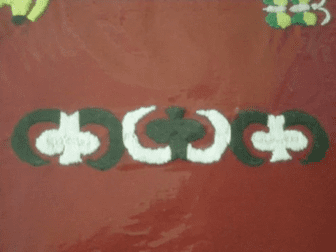
Manipur has a unique type of embroidery that uses one stitch, in deference to the weavers in the area. This is done in dark matching shade with untwisted silk thread on the border of the phanek (a lungi or lower body wrap worn by women). Colors in dark red, plum or chocolate are usually used. The embroidery is so artistically done that it does not clash with the weave and is often mistaken for it.
Akoybi embroidery is done in an elegant snake-like pattern or design, derived from the legendary snake, pakhamba (killed by the husband of a goddess, who later tried to atone for this act by imitating the pattern). Akoybi means circular and the design involves one circle joining the other, each broken further with a significant motif in shades of shades of red along with black and white. Hijay is another pattern where black and white, along with shades of pink thread are used in a continuous pattern.
Angami Naga shawls have animal motifs in black. This was previously called sami lami phee (which means warrior cloth of wild animals) and was given to brave distinguished warriors by the royalty, in recognition of their prowess and ability. The colours are bright green, red, yellow, and white. Abhala or mirror-embroidery work is done only on ras dance costume.
The indigenous inhabitants of Manipur are the meithei community. Their designs, called tindogbi, are inspired from a silk caterpillar sitting on a castor leaf and eating it. Possession of Shamilami fabric, which is a combination of weaving and embroidery, is considered a status symbol. Maibung is a natural design inspired from the natural finish of the wood.
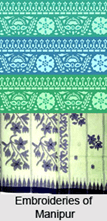
Techniques:-
Embroidery displays a combination of the cross-stitch and the line or double running stitch.Embroidery designs are prepared by fixing small round shaped mirrors to the material with the help of the buttonhole stitch, the outline being sketched by hand. Silken thread is used for the stitching done in stem or herring bone, closely worked.
TEXTILES OF MANIPUR
Changkhom
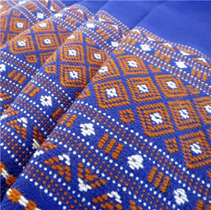
It is a shawl of Tangkhul tribe of Manipur. The Tangkhul have broadly eleven kinds of hand woven cloths. In most cases, these cloths have woven on Loin Loom (an indigenous looms). It is now gradually converting to produce on frame loom also. It is used by both men and women. These cloths exhibit ubiquitous characteristics. In most of Tangkhul cloth, Red colour has a major portion which is complemented by a little white and black. These cloths have now been diversified to many other products, like, wall hanging, cushion cover, curtain. These cloths produced both mercerized and acrylic yarn of 2/32s, 2/34s.
Raivat Kachon

It is also a shawl of Tangkhul tribe of Manipur. It is among the eleven kinds of hand woven cloths of their tribe. The cloth has been woven on Loin Loom with acrylic yarn both in warp and weft. The motifs of animals, insects have been are hand embroidered. It is now gradually converting to produce on frame loom also. It is generally used by women. This cloth also exhibit ubiquitous characteristics. This cloth has now been diversified to many other purposes. It is woven with mercerized or acrylic yarn of 2/32s, 2/34s.
Mareipan
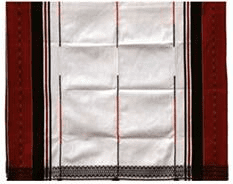
It is a shawl of Kabui tribe of Manipur. The Kabui has broadly fourteen kinds of hand woven cloths. Of these, seven are used by men and the remaining seven by women. In most cases, these cloths have woven on Loin Loom. It is now gradually converting to produce on frame loom also. These cloths has intricate hand woven extra weft designs on the border. In most of Kabui cloth, white colour has a major portion which is complemented by a little red and black. These cloths have now been diversified to many other products. These cloths produced both mercerized and acrylic yarn of 2/32s, 2/34s
Pheingao
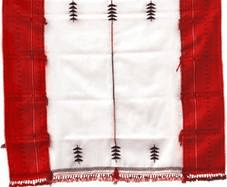
It is a shawl of Kabui tribe of Manipur. It is used both by men and women. In most cases, these cloths have woven on Loin Loom. It is now gradually converting to produce on frame loom also. These cloths has intricate hand woven extra weft designs on the border. In most of Kabui cloth, white colour has a major portion which is complemented by a little red and black. These cloths have now been diversified to many other products. These cloths produced both mercerized and acrylic yarn of 2/32s, 2/34s
Cotton
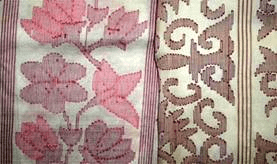
Sari in Manipur is the quintessential female garment. It is woven with 100% cotton with 100s. In most cases, cotton sari is woven on throw shuttle looms. In Manipur, Designs of saris are of a mixture of hill tribal textiles and that of floral designs, etc. In most cases, designs have been woven with traditional temple design in border and floral in cross border. Saris are diversified to many other products and purposes including curtain
Silk sari
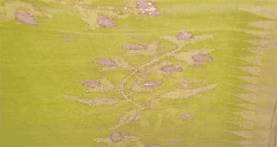
It is woven with 100% silk (Eri) with 20/22 Denier. In most cases, silk saris are woven on both throw and fly shuttle looms. Designs of saris are of a mixture of hill tribal textiles and that of floral designs, etc. In most cases, designs have been woven with traditional temple design in border and floral in cross border. Saris are diversified to many other products and purposes including curtain.
Haopheisoi (sarong)
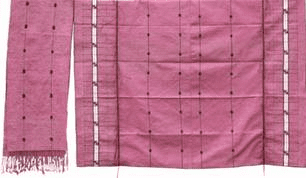
It is a diversified Hand Woven fabric on fly shuttle loom. It is woven with mercerized and acrylic yarn of 2/32s, 2/34sdeveloped by Kabui community under Deen Dayal Hathkargha Protsahan Yojana. Border and longitunal warp designs are traditional motifs with new colour warp and traditional knotting.
COSTUMES OF MANIPUR
The dresses of Manipur have been defining fashion since forever. They are known for carrying off ethnic fashion trends with much élan. A traditional Manipuri costume has a distinct style where comfort and functionality precede all. The outfits are vibrant and innovative and yet maintain the uniqueness of primal concepts. But the fashion statement has evolved; the younger generation is experimenting with new dynamics in the same traditional outfits leading to debonair looks in the time-honoured, customary clothes.
Here’s giving you an insight into Manipuri conventional wears to help you
decode the incredible style. You can mix and match and step up your fashion
game one notch from the ordinary.
Costumes for Women of Manipur:
- Innaphi and Phanek are the Manipuri traditional dress for women in Manipur.
- All Manipuri women wore these costumes.
- Phanek is worn like a sarong. It is a handwoven dress.
- The people also weave special Phanek, those called MayekNaibi which has horizontal stripes and very attractive to look.
- This dress gives an extra appearance to the women and glows the beauty of the wearer.
- Meitai Females only stitch a cloth which called Kanap Phanek.
- The Kanap Phanek seems in the design of skirt and Meitai females stitched it with various designs.Though there are many costumes worn during rituals, the major ones are ‘Lai-phi’ and ‘Chin-phi’. ‘Lai-Phi is another attractive cloth, which is in white color having a yellow border. ‘Chin-Phi’ is also another Manipuri traditional costume; the costumes made with embroidered Phanek.
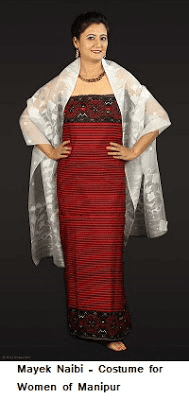
Costumes for Men of Manipur:
- Manipur Men wear their traditional costume white turban (pagri), dhoti with a jacket.
- The superior member of society wears cloth which called Khamen Chatpa.
- The Khamen Chatpa is generally worn on the ritual occasions. It is a ritual dhoti.
- In ancient period the kings gifted Khamen Chatpa to the Genius, Poets and well-known people as the gifts and award.
- Zamphie was worn during war by the warriors. Ningthoupee was worn by the king.

Traditional bridal dress of Manipur : Potloi
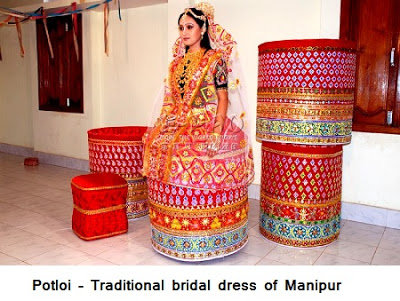
- Potloi is the traditional bridal dress of Manipur which gives bride an amazingly look.
- Shaped in a cylindrical form, it is stitched on the belt worn over it, the blouse and the inner garment.
- The skirt usually comes in red, pink and green colours and is adorned with traditional motifs; it is worn with the inaphi and a blouse made of rich fabrics.
- The potloi is decorated with applique works using geometrical figures and ornamented with sequins, studs and decorative stones.
- The beautiful dress is paired with a headband and rich jewelry.
- The traditional wedding of Manipur symbolizes immense joy and pleasure.
Modern clothing of Manipur
With development in economy, changes in society due to westernization and extension of Christianity, inhabitants of Manipur have become fashion conscious.
Shirts, t-shirts, jackets, jeans and skirts are common among youngsters. But they still like to wear their traditional costumes.
There are many modified attires as well. They are old fashioned clothes with contemporary changes. For example, Innaphi is a traditional dress of women which is worn with a modern skirt. These days, different types of materials are also used to make Innaphis.
Festival costumes of Manipur:
A wide range of attires are worn by the people during festivals of Manipur. In reality, there are different outfits for Manipur festivals. The Kumins and Potlois are worn in the Raas Leela festivals. There are some other dresses as well for festivals mainly for dance such as Phurits and Koks. Tribal dresses are Phiranji, Lmaphie, Ningthoupee and Saijounba.
Special Accessories & Jewelry
Ornaments add to the beauty of a person like dresses do. They have remained popular, even as metals they are made up of became dearer. India and Indian women are well known for beautiful ornaments and the costly metals that make them up are considered to be security for women, referred to as “Stree Dhan” in the country, literally meaning wealth of woman or wife. Ornaments have more relevance in Manipur, where women are generally fair and beautiful. The ornaments making them look even more elegant just like the shining land. The land of Manipur was itself known as Sna Laipak to the Meitheis of the state and Subarna Bhu to the rest of India, both signifying Land of Gold. This means that either gold was available in abundance or the land was known for consuming gold. Either way, it is certain that the land was linked with the precious yellow metal since mythical age. If they knew gold, the Manipuris also knew ornaments and therefore, they knew about silver and gems besides beads as well. In fact, the modern term “Manipur” means the land of gems. If the modern term and ancient terms of the land be linked, their literary meaning would be gold ornaments studded with gems.
The geographical situation of Manipur is such that people of different origins passed through it from east to west and from west to east. This not only made the human population a more hybrid one, but the admixture also brought in multiple concepts of creativity from multiple streams, making the resultant craft of Manipur more beautiful than its neighbours. This is also applicable to their ornaments, which are extremely beautiful and appealing, just like the damsels of the state. Their own charm and colourful attire adorned with beautiful ornaments made Manipur a land of fairies.
Ornaments of Manipur
Ornaments of Manipur range from those made of gold, silver and brass along with gems and beads, as well as ivory, shells, seeds and cane and bamboo leggings prevalent amongst the tribes.
Metals used in Ornaments of Manipur
The king is gone and in the democratic set up today, anyone can wear any ornaments of any metal including gold. This is of course when affordable and when there is no fear of demand of ransom from insurgents. During yesteryears however, gold was the privileged metal of the king and his family. It was reported to be plentiful. The chronicles contain a passage describing the magnificence of the table equipage of King Khagemba, who feasted in vessels of solid gold and sat on a chair of gold. Scholar T. C. Hodson in his book ‘The Meitheis’ recorded that the earrings worn by men and women are of plain gold, generally a thin casing over a solid piece of lac. Men do not wear any other ornaments. The necklaces donned by the upper class women are of simple and tasteful filigree designs manufactured by native goldsmiths, who prefer almost pure gold to work on, their tools not being tempered to be worked on alloyed gold. The bracelets and necklaces are chiselled and hammered patterns, while plain beads formed round a hollow nucleus of the sac are common. He also remarked that the jewellery manufactured in the state is of fair workmanship not distinguished by any special merit. Rings, bracelets and necklaces are the articles chiefly made, along with a large number of brass and bell metal armlets characterised for the hill men.
The use of gold for jewellery making was more plentiful among the Meitheis than any other metal. But it is also factual that a class of workers during the feudal Manipur period called Konsangs, were supposed to look after the manufacture of silver and brass vessels. This shows that silver and brass were not unknown to the Manipuris. In spite of the fact that gold is still preferred, they also make silver ornaments and it is more so today when the soaring prices is making gold beyond the reach of commoners, although in many cases, they use silver plated with gold.


Beads and Gems used in Ornaments of Manipur
The use of beads in making ornaments is also fairly common. Beads are usually used for making necklaces, made by making garlands by passing thread through the beads. Designs are several and sometimes several garlands are combined to make a single necklace.
The Meitheis knew the use of gems. Many of their traditional gold ornaments are studded with gems of various kinds. It is said that the local gems are available in the Chandel and Ukhrul districts. Traditionally, the Meitheis used to buy the raw gems from the tribes, cut and polish their own way and use them in jewellery. Sometimes they used to bring gems from Burma as well as rest of India. But in the recent past, many of them have acquired the knowledge of gem cutting in modern technique, while also having completed degrees and diplomas in gemmology. It is said that the finished gem from Manipur is of international standards. Gem dealers of Jaipur and Mumbai are getting their products finished from Manipur, since it can be done in a finer way at low cost. Thus, the ornaments of Manipur today have a better dazzle.
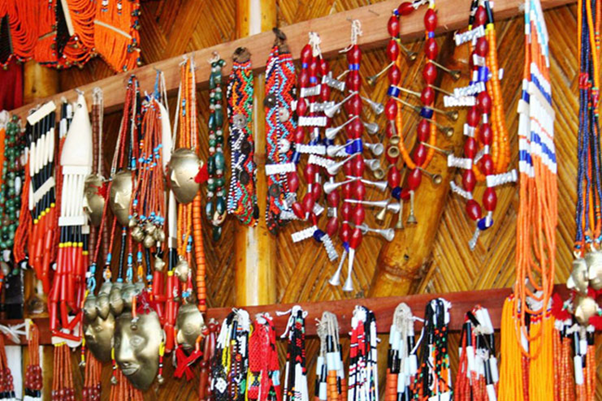
Tribal Ornaments of Manipur
The tribal ornaments of Manipur are typically different. While making ornaments, the tribes rarely use metals. They procure ornaments made of metals from the Meitheis or from Assam. Their exclusivity in ornaments lies in bead ornaments, ivory armlets and ornaments from seeds or beetles.

The tribal armlets are mostly hollowed ivory rings or rings of shells, either made by themselves or procured from outside. Brass and bell metal armlets and bangles are usually acquired from the Meitheis. Necklaces and necklets are usually made using beads, which are either made from bone of animals they consume or seeds of certain plants. The beads are round or cylindrical, polished by hand by rubbing against stone, with a thorough hole at the centre. Necklaces are made by passing strings through the beads with help of a needle. As variation in design, cowries are occasionally used in between. Beads are of multiple colours and necklaces are made of several layers depending on chosen design. These bead necklaces are often part of their dancing attire. On such bead necklaces, red, black and white beads come really attractive.

Often, wrist bands are made out of beads the same way as necklaces. They match the necklaces made. Bead hair bands are also quite appealing. Many tribes also use bamboo or cane legging dyed with vegetable dyes as ornaments. These leggings are coiled after heating according to size of the wearer and then dyed. Cane or bamboo ear and nose studs were common, along with cane armlets or wristlets dyed and adorned with bird feathers.
Manipur, thus, has a very rich and vibrant tradition of ornaments and ornament making, some flourishing while some others languishing, depending upon social changes and market demand. With more appropriate inputs, ornaments of Manipur can be further promoted.
Tourism guide:- https://www.manipurtourism.gov.in/
The article was written by – Ms. Ayman Satopay. B.Sc in Textile and Apparel Design from Sir Vithaldas Thackersey College Of Home Science. Textile Value Chain intern. Email: tvcmedia.digital@gmail.com

